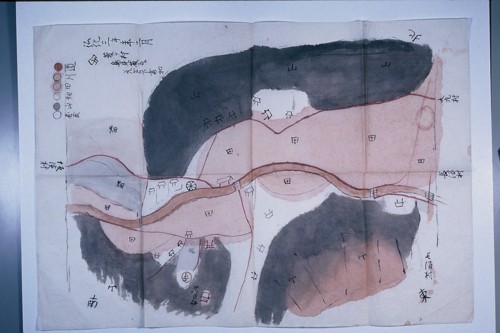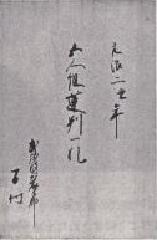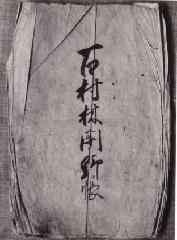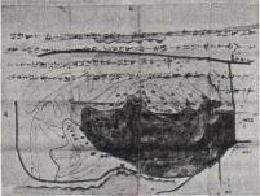Enomoto family documents (Enomoto family documents)
Update date: June 27, 2017

Picture of Hyakumura (Kouka 3rd year)
The Enomoto family in Hyakumura owns 81 old documents from the Edo period. The contents of the documents are as follows: Land survey book (A land register that surveys fields and compiles the results for each village) Five-person group book The documents include the "Hyakumura" (a system of collective responsibility for groups of five people to ensure tax collection and prevent crime), village maps, and other historical documents that shed light on the state of the 100 villages of the Edo period. Kanbun The collection spans a period of 203 years, from 1667 to 1870. Among the precious documents from the early modern period, we will introduce some particularly important basic historical materials. (Note that the Enomoto family also preserves modern historical materials from the Meiji period onwards.)
Five-person group, one bill (Enomoto Family Documents 43)
Genji This is a list of the Gonin Gumi made in 1865, and contains the rules and regulations of the Gonin Gumi and prohibited items. The contents are as follows: Tax Delivery The most common clause is about the Summon matters related to maintaining public order, such as the arrest of suspects, matters related to land, such as buying and selling land and pawning land, matters related to prohibiting crop failures in fields, etc. Nitta The document lists 10 items in total, including the promotion of farming, the prevention of misconduct by government officials against farmers, etc. Eternal prohibition on the sale of farmland or Keian of Imperial edict It is clear that it was made in response to the laws and regulations of the Edo Shogunate, such as:
Hyakumura Forest Opening Record (Enomoto family documents 1)
Genroku This is a land survey ledger that is believed to have been created during the land survey carried out in the Kanto region in 1695. Bunroku The oldest known land survey of Sakahama Village is from 1594, but according to existing historical documents, Kanei Following the Hirao village land survey conducted in 1626, this 100 village land survey conducted in 1691 is an older historical document that can tell us about the village conditions of the 100 villages in the early Edo period.
Awakening ( Notice regarding bribes from the Gotaka Department ) (Enomoto Family Documents 49)
It is a game in which a trained falcon is used to capture prey. Hawking Falconry has been practiced since ancient times, and the successive Shoguns of the Edo Shogunate also enjoyed it. Hawk Ground The maintenance was carried out. The 5th Shogun Tsunayoshi It was temporarily suspended during the reign of the eighth shogun Yoshimune During the Edo period, the falconry training grounds were restored and the falconry training grounds were strengthened. Cattle farm It is designated as Falconer There was also a lot of traffic between the hawking grounds and the officials related to the hawking grounds. Shimofuda Post Town We will be bringing the necessary items (firewood, charcoal, rice, etc.) to stay at the campsite. Accommodation To deliver to the Fuchu-juku Wholesaler ( Caretaker ) to Hyakumura Headman The villages of Inagi provided transportation and supplies for the Takaba officials whenever they traveled to and from the area.
Hyakumura Illustration (Enomoto Family Documents 67 and 68)
The Enomoto family has seven 100 Village Maps from the Edo period. Of these, only two, 67 and 68, are known to have known dates. Kanbun 7th year (1667) and Koka It was created in 1846. The map of 67 (Kanbun 7) shows a dispute between Naganuma Village and Hyakumura Village. Common land This is a diagram showing the decision of the dispute over the use of the field. The field was used by the three villages of Hyakumura, Sakahamamura, and Omarumura, but Naganumamura was taken over by the other villages. Membership Use This caused a dispute and a lawsuit was filed at the Shogunate's Hyojosho. Membership rights I acknowledged that, Tax The delivery destination of the goods was the feudal lords of three villages. The map of No. 68 (the 3rd year of the Koka era) is a very simplified drawing of a hundred villages, with roads, rivers, rice fields, farms, forests, temples, houses, etc., all depicted in different colors.

"Gonin-gumi ichiban"

"Hyakuson Forest Open Field Book"

``Kaku'' (touch for Otakakata)

"Hyakumura Picture" (Kanbun 7th year)












